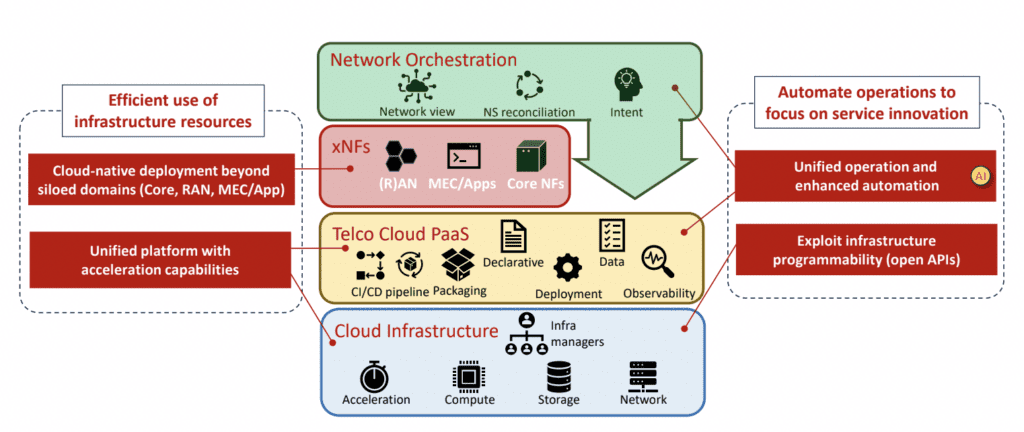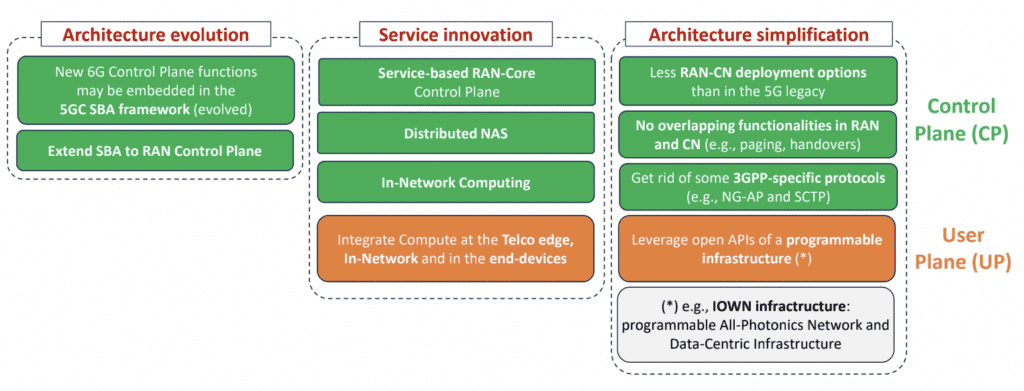The evolution from 5G to 6G core networks includes new requirements for AI, interoperability, positioning, sensing, sustainability and more
The current emphasis on bringing cloud-native technology and operating principles into 5G—with the move to a Standalone 5G architecture and cloud-native 5G core the next major transition—will inform how 6G is designed, standardized and deployed. Beyond a number of 5G core enhancements that will go into 6G, the next generation of cellular will also include a number of new requirements.
During the recent Telco Cloud and Edge Forum, available on-demand here, Riccardo Guerzoni, director of the core network group at Docomo Euro-Labs, laid out the path from 5G to 6G with an emphasis on core network considerations. He focused on five design considerations that, broadly speaking, speak to infrastructure/platform and 3GPP architectural perspectives.
An overarching point, according to Guerzoni is that 6G, and the enhancements and new requirements that will come with it, need to be aligned with the economic reality operators are facing and need to deliver a clear return on investment. “These new requirements for beyond 5G are challenging in terms of environmental sustainability, which means energy efficiency, hardware longevity and economic viability,” he said. “These innovative services that are expected in the 2030s that required enhanced performance of the network and new functionalities, and that must be justified in terms of return of the investment. So the point is how to make these new services that are very demanding economically viable.”

The first set of considerations articulated by Guerzoni speak to the infrastructure/platform piece. Efficient use of infrastructure resources contemplates cloud-native deployment that dispenses with legacy silos, e.g. core, RAN, mobile edge computing and network applications, and a unified underlying platform with acceleration capabilities. Then, automated operations that enable service innovations covers unified automation and operations, and explaining infrastructure programmability via network APIs.
“There is a cloud infrastructure with the telco cloud platform as a service built on top of it, and that’s the enabler for a unified platform with acceleration capabilities,” Guerzoni explained. “So acceleration capabilities are important to deploy not only the core network functions like it is in 5G, but also run components [like open distributed units]…And also applications. So the idea is that these acceleration capabilities will be used not only to host RAN components, but also application-related components that can be provided by the operator itself, or also on behalf of third parties.”

As it relates to the 3GPP-defined architecture, there are three primary considerations:
- Architecture evolution—new 6G control plane functions potentially embedded in an evolved 5G core service-based architecture framework, and extending the service-based architecture to the RAN control plane.
- Service innovation—a service-based RAN/core control plane, distributed non-access stratum, in-network computing, and integration of compute at the telco edge, building on compute in-network and on-device.
- Architecture simplification—fewer RAN/core deployment options, no overlapping RAN/core functions like paging and handover, removing some 3GPP-specific protocols like NG-AP and SCTP, leveraging the programmable infrastructure, and programmable all-photonics network and data center infrastructure.
“Regarding the extension of the SBA architecture defined for 5G to host the 6G control plane functions, the figure [above] shows a possible perspective that can be used as an approach in the 3GPP standardization, where 6G core network functions and 6G RAN controlpPlane function could be hosted in the same 5G SBA framework, enhanced of course,” Guerzoni said. “The enhancement is necessary if we consider that currently the 5G core functions are deployed in a centralized cloud, while if we involve the SBA framework also functions at the edge, like RAN control plane functions, then we need to potentially make the protocol stank more resilient.”
He also pointed out that with 6G “there is no Non-standalone option…That’s a lesson learned from the 5G experience…The 6G RAN is only integrated with 6G core network functions, and it doesn’t interact directly with the 5G core network functions. And the interworking is realized by means of service-based interaction between the 5G core and the 6G core.”
Drawing from the cloud-native descriptor applied to 5G, 6G is often characterized as AI-native. Speaking to this point, Guerzoni said, “AI capabilities can be embedded to make more efficient the network…functionalities. And reduce the energy consumption, optimize the control plane behavior, quality of experience, quality of service, and so on and so on. So there will be AI models embedded in different part[s] of the network, and this is of course a big opportunity but it’s also a challenge from the mobile network operator point of view because these [machine learning] models need to be managed in order to build the models, deploy them, monitor the performance, make them controllable, train and evaluate the models. So this is a quite important topic for our mobile network operators—how to make controllable and observable these ML models that are deployed in the different parts of the network.”

